Major Ion Chemistry of Waters and Possible Controls under Winter Irrigation in the Saline Land of Arid Regions
Abstract
1. Introduction
2. Materials and Methods
2.1. Site Description
2.2. Sample Collection
2.3. Sample Measurements
2.3.1. Hydrogen and Oxygen Isotopes
2.3.2. Major Ions
3. Results and Discussion
3.1. Isotopic Characteristics
3.2. Hydrochemical Characteristics
3.3. Hydrochemical Type
3.4. Factors Controlling Dissolved Solutes
3.5. Origins of Major Ions
4. Conclusions
Author Contributions
Funding
Data Availability Statement
Acknowledgments
Conflicts of Interest
References
- Liu, Y.; Ao, C.; Zeng, W.Z.; Srivastava, A.K.; Thomas, G.; Wu, J.W.; Huang, J.S. Simulating water and salt transport in subsurface pipe drainage systems with HYDRUS-2D. J. Hydrol. 2021, 592, 125823. [Google Scholar] [CrossRef]
- Zhao, S.L.; Gupta, S.C.; Huggins, D.R.; Moncrief, J.F. Predicting Subsurface Drainage, Corn Yield, and Nitrate Nitrogen Losses with DRAINMOD-N. J. Environ. Qual. 2000, 29, 817–825. [Google Scholar] [CrossRef]
- Yang, Y.; Zhu, Y.; Wu, J.W.; Mao, W.; Ye, M.; Yang, J.Z. Development and application of a new package for MODFLOW-LGR-MT3D for simulating regional groundwater and salt dynamics with subsurface drainage systems. Agric. Water Manag. 2022, 260, 107330. [Google Scholar] [CrossRef]
- Yang, Y.N.; Sheng, Q.; Zhang, L.; Kang, H.Q.; Liu, Y. Desalination of saline farmland drainage water through wetland plants. Agric. Water Manag. 2015, 156, 19–29. [Google Scholar] [CrossRef]
- Jia, Z.; Luo, W.; Xie, J.; Pan, Y.; Chen, Y.; Tang, S.; Liu, W. Salinity dynamics of wetland ditches receiving drainage from irrigated agricultural land in arid and semi-arid regions. Agric. Water Manag. 2011, 100, 9–17. [Google Scholar] [CrossRef]
- Askri, B.; Bouhlila, R.; Job, J.O. Development and application of a conceptual hydrologic model to predict soil salinity within modern Tunisian oases. J. Hydrol. 2010, 380, 45–61. [Google Scholar] [CrossRef]
- Hornbuckle, J.W.; Christen, E.W.; Faulkner, R.D. Evaluating a multi-level subsurface drainage system for improved drainage water quality. Agric. Water Manag. 2007, 89, 208–216. [Google Scholar] [CrossRef]
- Deverel, S.J.; Fio, J.L. Groundwater Flow and Solute Movement to Drain Laterals, Western San Joaquin Valley, California: 1. Geochemical Assessment. Water Resour. Res. 1990, 27, 2233–2246. [Google Scholar] [CrossRef]
- Feng, G.X.; Zhang, Z.Y.; Wan, C.Y.; Lu, P.R.; Bakour, A. Effects of saline water irrigation on soil salinity and yield of summer maize(Zea mays L.) in subsurface drainage system. Agric. Water Manag. 2017, 193, 205–213. [Google Scholar] [CrossRef]
- Bassil, E.S.; Kaffka, S.R. Response of safflower (Carthamus tinctorius L.) to saline soils and irrigation: I. Consumptive water use. Agric. Water Manag. 2002, 54, 67–80. [Google Scholar] [CrossRef]
- Bahceci, I.; Dinc, N.; Tari, A.F.; Agar, A.I.; Sonmez, B. Water and salt balance studies, using SaltMod, to improve subsurface drainage design in the Konya–umra Plain, Turkey. Agric. Water Manag. 2007, 85, 261–271. [Google Scholar] [CrossRef]
- Parsons, J.; Skaggs, R.; Doty, C. Simulation of controlled drainage in open-ditch drainage systems. Agric. Water Manag. 1990, 18, 301–316. [Google Scholar] [CrossRef]
- Hu, Q.L.; Yang, Y.H.; Han, S.M.; Wang, J.S. Degradation of agricultural drainage water quantity and quality due to farmland expansion and water-saving operations in arid basins. Agric. Water Manag. 2019, 213, 185–192. [Google Scholar] [CrossRef]
- Ledesma-Ruiz, R.; Pastén-Zapata, E.; Parra, R.; Harter, T.; Mahlknecht, J. Investigation of the geochemical evolution of groundwater under agricultural land: A case study in northeastern Mexico. J. Hydrol. 2015, 521, 410–423. [Google Scholar] [CrossRef]
- Filella, M.; Pomian-Srzednicki, I.; Nirel, P.M. Development of a powerful approach for classification of surface waters by geochemical signature. Water Res. 2014, 50, 221–228. [Google Scholar] [CrossRef]
- Li, X.; Tang, C.Y.; Cao, Y.J.; Dan, L. A multiple isotope (H, O, N, C and S) approach to elucidate the hydrochemical evolution of shallow groundwater in a rapidly urbanized area of the Pearl River Delta, China. Sci. Total Environ. 2020, 724, 137930. [Google Scholar] [CrossRef]
- Mondal, N.C.; Singh, V.P. Hydrochemical analysis of salinization for a tannery belt in Southern India. J. Hydrol. 2011, 405, 235–247. [Google Scholar] [CrossRef]
- Resz, M.A.; Roman, C.; Senila, M.; Török, A.I.; Kovacs, E. A Comprehensive Approach to the Chemistry, Pollution Impact and Risk Assessment of Drinking Water Sources in a Former Industrialized Area of Romania. Water 2023, 15, 1180. [Google Scholar] [CrossRef]
- Röper, T.; Kröger, K.F.; Meyer, H.; Sültenfuss, J.; Greskowiak, J.; Massmann, G. Groundwater ages, recharge conditions and hydrochemical evolution of a barrier island freshwater lens (Spiekeroog, Northern Germany). J. Hydrol. 2012, 454, 173–186. [Google Scholar] [CrossRef]
- Yin, Z.Y.; Luo, Q.K.; Wu, J.F.; Xu, S.H.; Wu, J.C. Identification of the long-term variations of groundwater and their governing factors based on hydrochemical and isotopic data in a river basin. J. Hydrol. 2021, 592, 125604. [Google Scholar] [CrossRef]
- Apollaro, C.; Fuoco, I.; Gennaro, E.; Giuliani, L.; Iezzi, G.; Marini, L.; Radica, F.; Di Luccio, F.; Ventura, G.; Vespasiano, G. Advanced argillic alteration at Cave di Caolino, Lipari, Aeolian Islands (Italy): Implications for the mitigation of volcanic risks and the exploitation of geothermal resources. Sci. Total Environ. 2023, 889, 164333. [Google Scholar] [CrossRef] [PubMed]
- Gibbs, R.J. Mechanisms controlling world water chemistry. Science 1970, 170, 1088–1090. [Google Scholar] [CrossRef] [PubMed]
- Apollaro, C.; Marini, L.; De Rosa, R.; Settembrino, P.; Scarciglia, F.; Vecchio, G. Geochemical features of rocks, stream sediments, and soils of the Fiume Grande Valley (Calabria, Italy). Environ. Geol. 2007, 52, 719–729. [Google Scholar] [CrossRef]
- Hanshaw, B.B.; Back, W. Major geochemical processes in the evolution of carbonate—Aquifer systems. J. Hydrol. 1979, 43, 287–312. [Google Scholar] [CrossRef]
- Lawrence, F.W.; Upchurch, S.B. Identification of recharge areas using geochemical factor analysis. Groundwater 1982, 20, 680–687. [Google Scholar] [CrossRef]
- Rao, N.S.; Rao, P.S.; Reddy, G.V.; Nagamani, M.; Vidyasagar, G.; Satyanarayana, N.L.V.V. Chemical characteristics of groundwater and assessment of groundwater quality in Varaha River Basin, Visakhapatnam District, Andhra Pradesh, India. Environ. Monit. Assess. 2012, 184, 5189–5214. [Google Scholar] [CrossRef]
- Kim, H.-S.; Park, S.-R. Hydrogeochemical characteristics of groundwater highly polluted with nitrate in an agricultural area of Hongseong, Korea. Water 2016, 8, 345. [Google Scholar] [CrossRef]
- Abou Zakhem, B.; Hafez, R. Hydrochemical, isotopic and statistical characteristics of groundwater nitrate pollution in Damascus Oasis (Syria). Environ. Earth Sci. 2015, 74, 2781–2797. [Google Scholar] [CrossRef]
- Lambs, L. Interactions between groundwater and surface water at river banks and the confluence of rivers. J. Hydrol. 2004, 288, 312–326. [Google Scholar] [CrossRef]
- Chiogna, G.; Santoni, E.; Camin, F.; Tonon, A.; Majone, B.; Trenti, A.; Bellin, A. Stable isotope characterization of the Vermigliana catchment. J. Hydrol. 2014, 509, 295–305. [Google Scholar] [CrossRef]
- McCarthy, K.A.; McFarland, W.D.; Wilkinson, J.M.; White, L.D. The dynamic relationship between ground water and the Columbia River: Using deuterium and oxygen-18 as tracers. J. Hydrol. 1992, 135, 1–12. [Google Scholar] [CrossRef]
- Qiu, X.; Zhang, M.J.; Wang, S.J. Preliminary research on hydrogen and oxygen stable isotope characteristics of different water bodies in the Qilian Mountains, northwestern Tibetan Plateau. Environ. Earth Sci. 2016, 75, 149. [Google Scholar] [CrossRef]
- Taniguchi, M.; Kaihotsu, I.; Kotoda, K. Isotope studies of precipitation, river water and groundwater in the HEIFE area, northwestern China. J. Meteorol. Soc. Jpn. Ser. II 1995, 73, 1293–1299. [Google Scholar] [CrossRef][Green Version]
- Fernández-Chacón, F.; Benavente, J.C.; Rubio-Campos, J.C.; Kohfahl, C.; Jiménez, J.; Meyer, H.; Hubberten, H.; Pekdeger, A. Isotopic composition (δ18O and δD) of precipitation and groundwater in a semi-arid, mountainous area (Guadiana Menor basin, Southeast Spain). Hydrol. Process 2010, 24, 1343–1356. [Google Scholar] [CrossRef]
- Keene, W.C.; Pszenny, A.A.; Galloway, J.N.; Hawley, M.E. Sea-salt corrections and interpretation of constituent ratios in marine precipitation. J. Geophys. Res. 1986, 91, 6647–6658. [Google Scholar] [CrossRef]
- Nogueira, G.; Stigter, T.Y.; Zhou, Y.; Mussa, F.; Juizo, D. Understanding groundwater salinization mechanisms to secure freshwater resources in the water-scarce city of Maputo, Mozambique. Sci. Total Environ. 2019, 661, 723–736. [Google Scholar] [CrossRef]
- Piper, A.M. A graphic procedure in the geochemical interpretation of water-analyses. Eos Trans. Amer Geophys. Union. 1944, 25, 914–928. [Google Scholar]
- Sun, Y.; Liu, Z.G.; Hou, X.M.; Zhou, X. Quality assessment for shallow groundwater in the Hefei area, Anhui Province. East. China Geol. 2019, 40, 74–80. (In Chinese) [Google Scholar]
- Lin, C.Y.; Abdullah, M.H.; Praveena, S.M.; Yahaya, A.H.B.; Musta, B. Delineation of temporal variability and governing factors influencing the spatial variability of shallow groundwater chemistry in a tropical sedimentary island. J. Hydrol. 2012, 432, 26–42. [Google Scholar] [CrossRef]
- Jin, Y.; Jiang, Y.H.; Zhou, Q.P.; Lei, T.; Jia, J.Y.; Yang, G.Q. Evolution characteristics and genesis of shallow groundwater in Lücheng area of Danyang City. East. China Geol. 2021, 42, 475–482. (In Chinese) [Google Scholar]
- Zhai, Y.Z.; Zheng, F.X.; Zhao, X.B.; Xia, X.L.; Teng, Y.G. Identification of hydrochemical genesis and screening of typical groundwater pollutants impacting human health: A case study in Northeast China. Environ. Pollut 2019, 252, 1202–1215. [Google Scholar] [CrossRef] [PubMed]
- Magesh, N.S.; Botsa, S.M.; Dessai, S.; Mestry, M.; Leiao, T.D.L.; Tiwari, A. Hydrogeochemistry of the deglaciated lacustrine systems in Antarctica: Potential impact of marine aerosols and rock-water interactions. Sci. Total Environ. 2020, 706, 135822. [Google Scholar] [CrossRef] [PubMed]
- Marandi, A.; Shand, P. Groundwater chemistry and the Gibbs Diagram. Appl. Geochem. 2018, 97, 209–212. [Google Scholar] [CrossRef]
- Shen, B.B.; Wu, J.L.; Zhan, S.; Jin, M.; Saparov, A.S.; Abuduwaili, J. Spatial variations and controls on the hydrochemistry of surface waters across the Ili-Balkhash Basin, arid Central Asia. J. Hydrol. 2021, 600, 126565. [Google Scholar] [CrossRef]
- Srivastava, S.K. Assessment of groundwater quality for the suitability of irrigation and its impacts on crop yields in the Guna district, India. Agric. Water Manag. 2019, 216, 224–241. [Google Scholar] [CrossRef]
- Nejatijahromi, Z.; Nassery, H.R.; Hosono, T.; Nakhaei, M.; Alijani, F.; Okumura, A. Groundwater nitrate contamination in an area using urban wastewaters for agricultural irrigation under arid climate condition, southeast of Tehran, Iran. Agric. Water Manag. 2019, 221, 397–414. [Google Scholar] [CrossRef]
- Nguyen, T.T.; Kawamura, A.; Tong, T.N.; Nakagawa, N.; Amaguchi, H.; Gilbuena, R. Clustering spatio-seasonal hydrogeochemical data using self-organizing maps for groundwater quality assessment in the Red River Delta, Vietnam. J. Hydrol. 2015, 522, 661–673. [Google Scholar] [CrossRef]
- Yin, C.Y.; Zhao, J.; Chen, X.B.; Li, L.J.; Liu, H.; Hu, Q.L. Desalination characteristics and efficiency of high saline soil leached by brackish water and Yellow River water. Agric. Water Manag. 2022, 263, 107461. [Google Scholar] [CrossRef]
- Mondal, N.C.; Singh, V.P.; Singh, V.S.; Saxena, V.K. Determining the interaction between groundwater and saline water through groundwater major ions chemistry. J. Hydrol. 2010, 388, 100–111. [Google Scholar] [CrossRef]
- Meier, S.D.; Atekwana, E.A.; Molwalefhe, L.; Atekwana, E.A. Processes that control water chemistry and stable isotopic composition during the refilling of Lake Ngami in semiarid northwest Botswana. J. Hydrol. 2015, 527, 420–432. [Google Scholar] [CrossRef]
- Rosenthal, E.; Zilberbrand, M.; Livshitz, Y. The hydrochemical evolution of brackish groundwater in central and northern Sinai (Egypt) and in the western Negev (Israel). J. Hydrol. 2007, 337, 294–314. [Google Scholar] [CrossRef]
- Luo, J.X. SALINE-Alkali Land Improvement in Xinjiang Reclamation Area; Water Resources and Electric Power Press: Beijing, China, 1985. (In Chinese) [Google Scholar]
- Ayimah, J.Y. Hydrogeochemical Studies of Groundwater in the Southwestern Coastal Districts of the Central Region, Ghana; University of Ghana: Accra, Ghana, 2014. [Google Scholar]
- Chen, S.; Mao, X.M.; Shang, S.H. Response and contribution of shallow groundwater to soil water/salt budget and crop growth in layered soils. Agric. Water Manag. 2022, 266, 107574. [Google Scholar] [CrossRef]
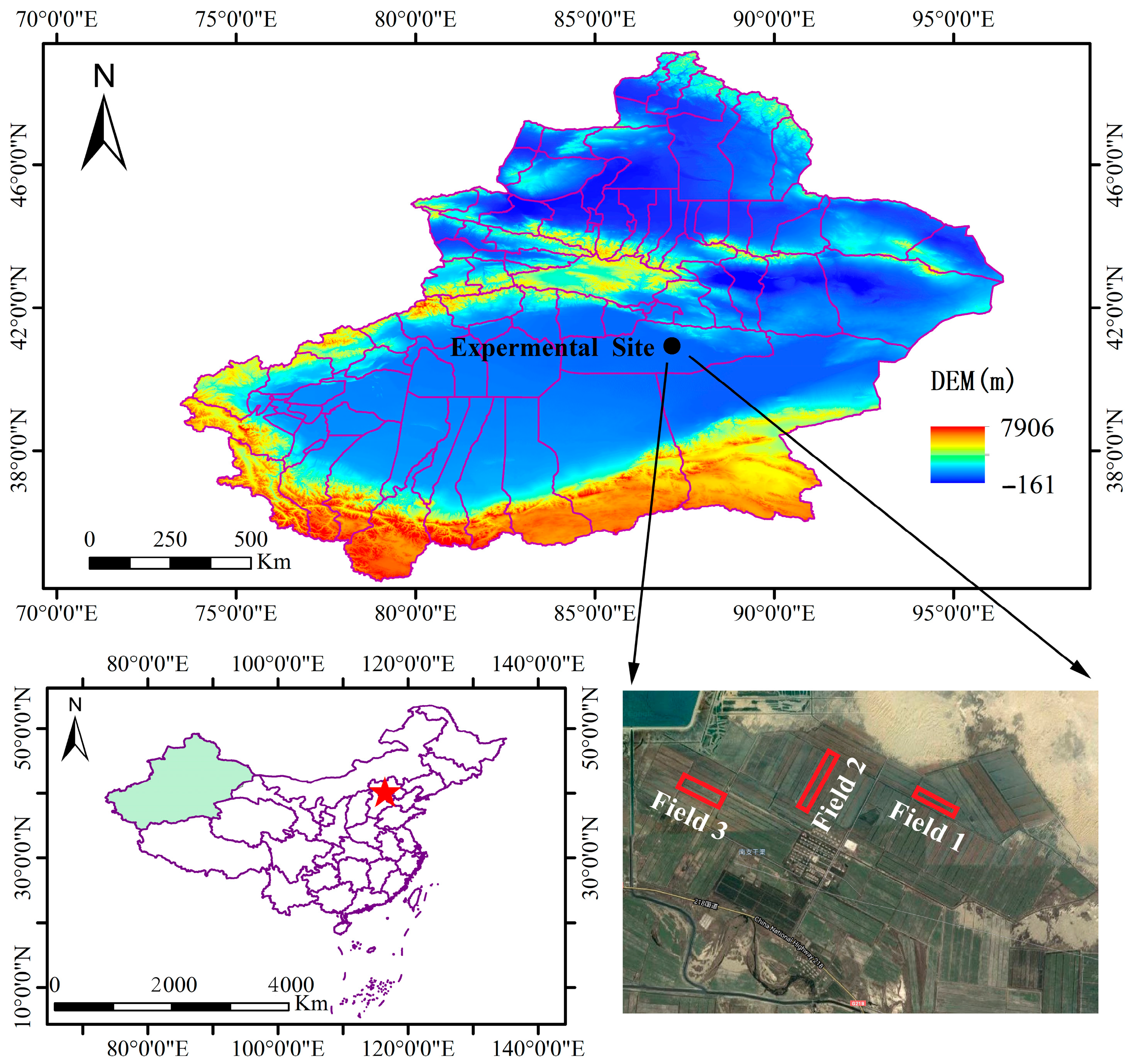

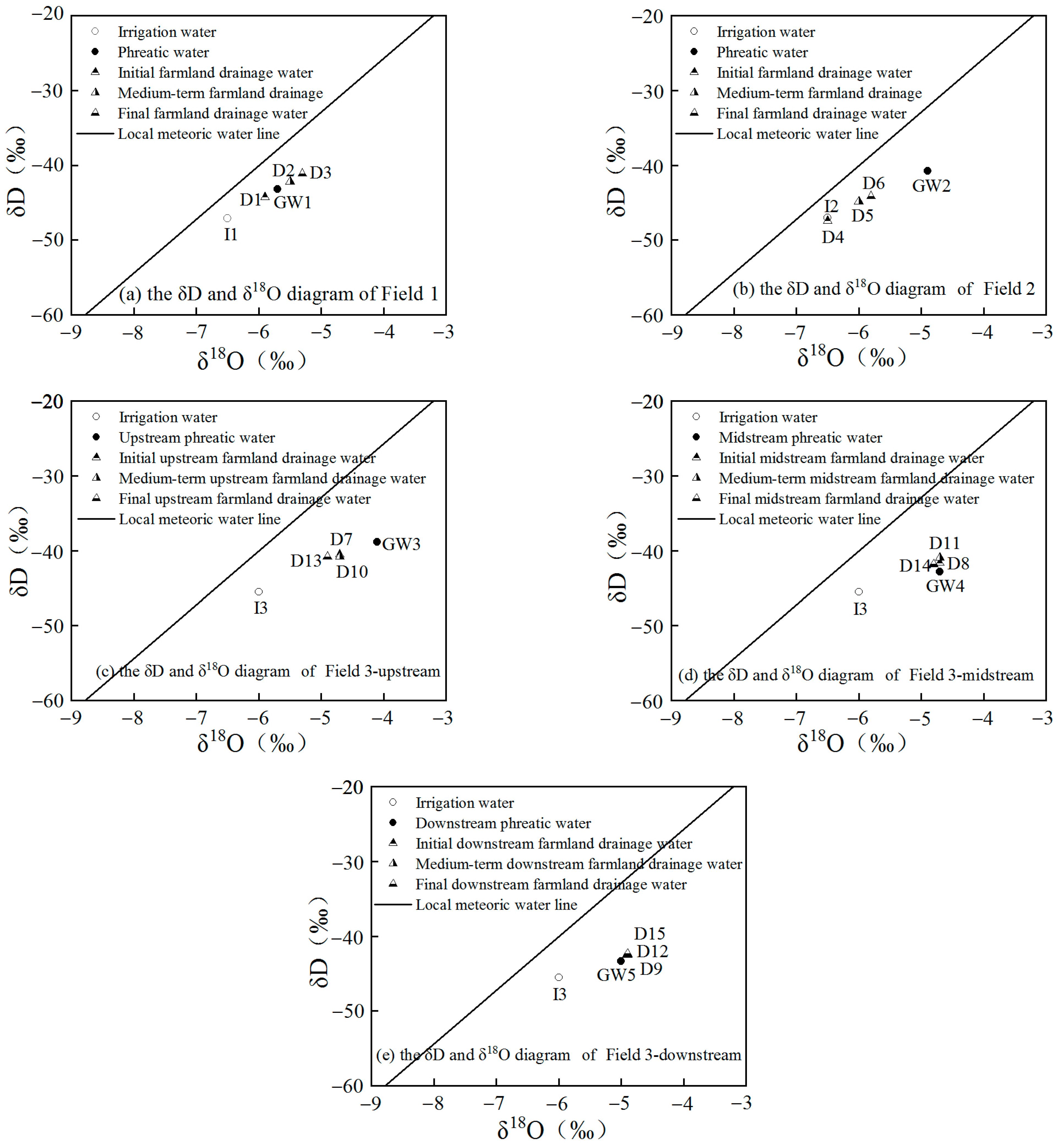

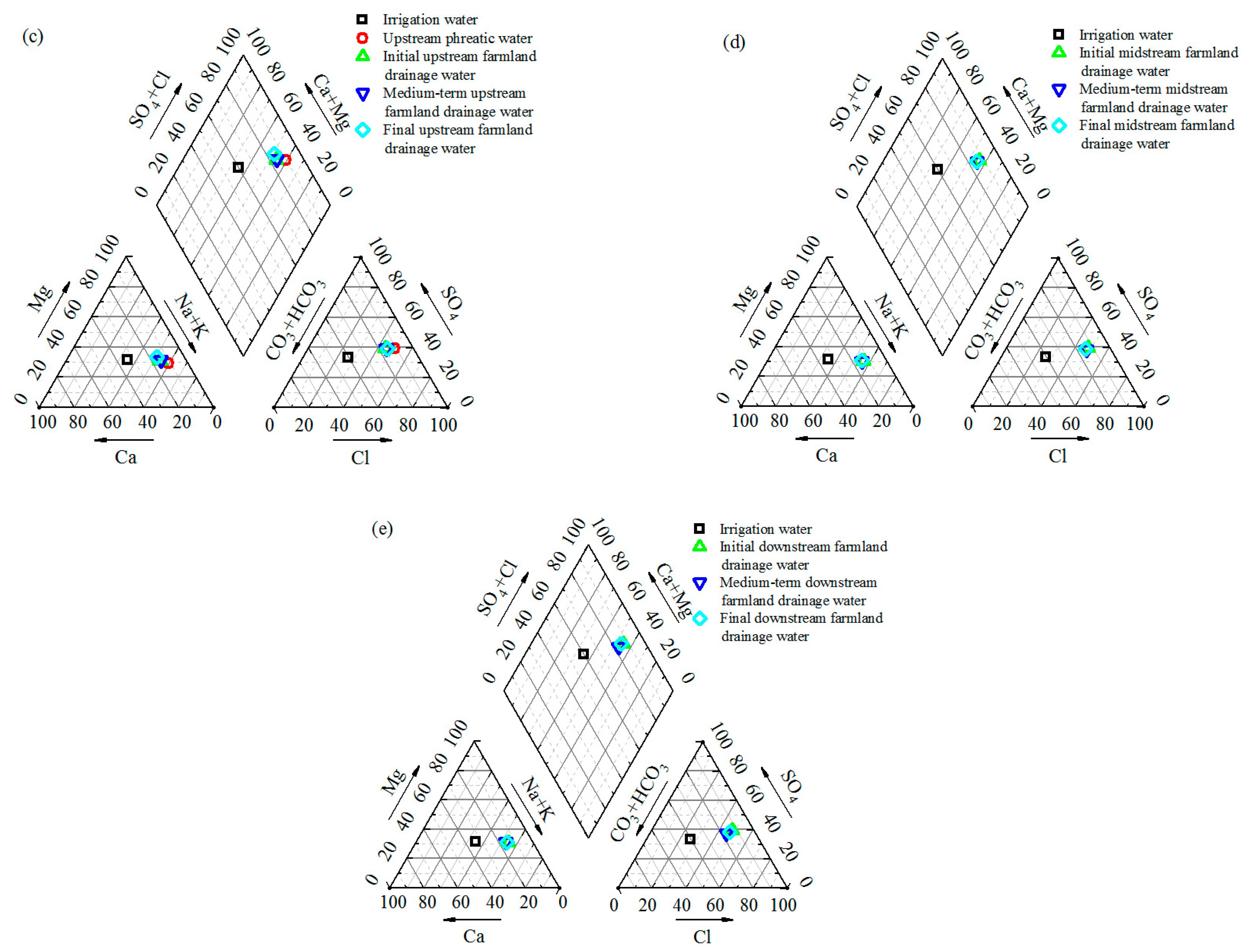

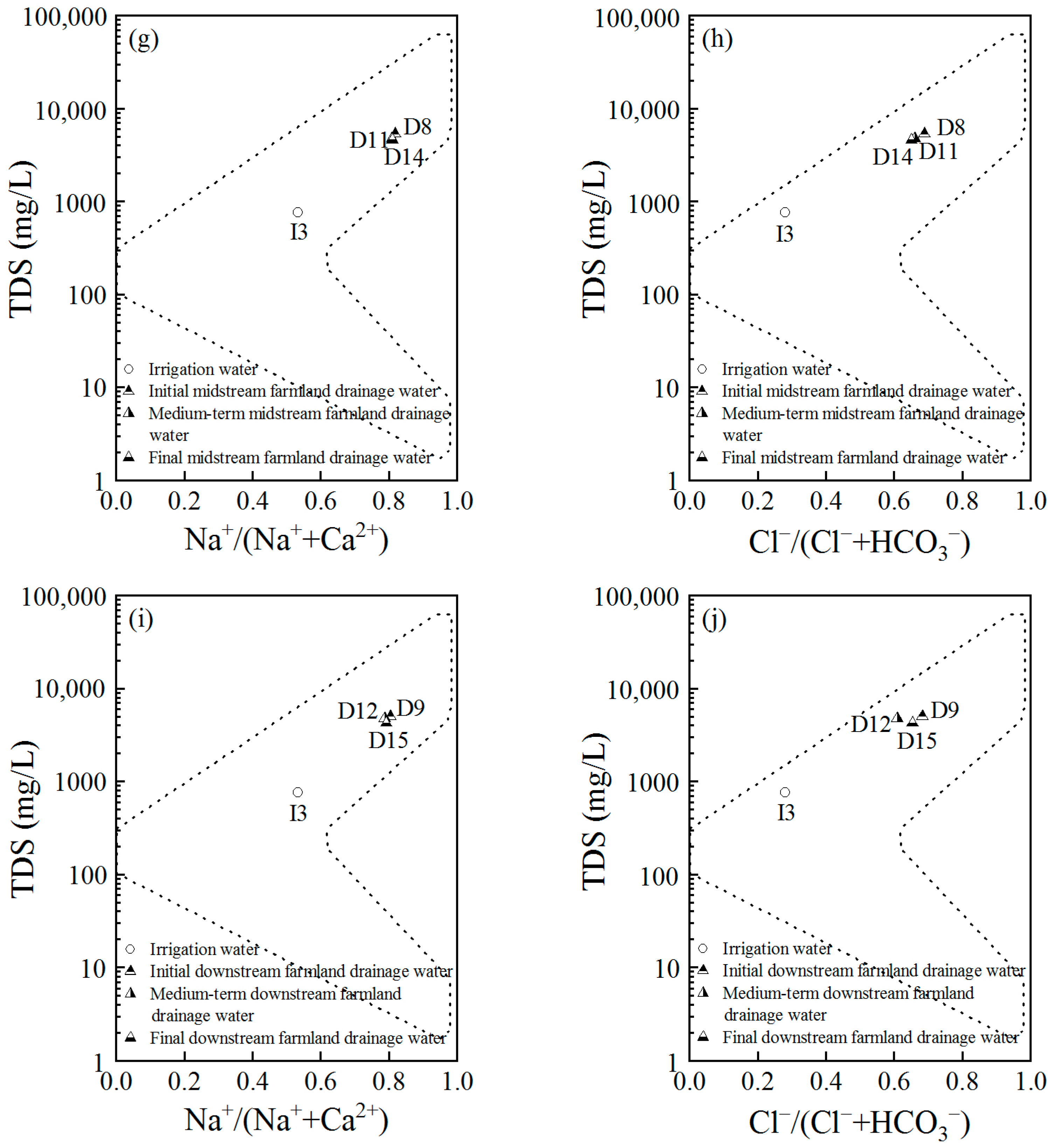
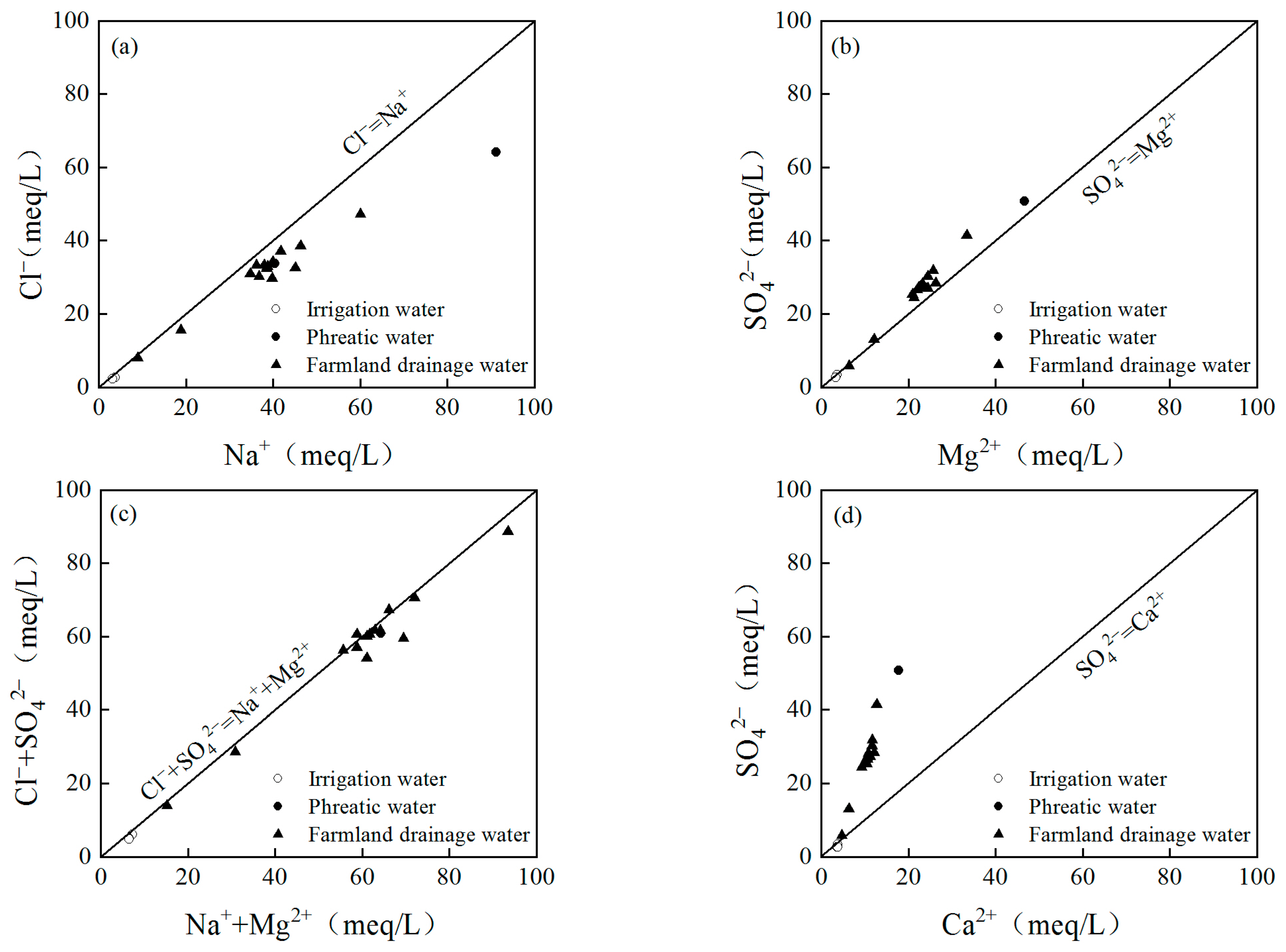

| Field | Type | Sample No. | δD (‰) | δ18O (‰) | Sampling Date | Note |
|---|---|---|---|---|---|---|
| Field 1 | Irrigation water | I1 | −47.1 | −6.5 | 21 November 2019 | |
| Phreatic water | GW1 | −43.2 | −5.7 | 20 November 2019 | * | |
| Initial farmland drainage water | D1 | −44.2 | −5.9 | 27 November 2019 | ||
| Medium-term farmland drainage | D2 | −42.2 | −5.5 | 1 December 2019 | ||
| Final farmland drainage water | D3 | −41.1 | −5.3 | 4 December 2019 | ||
| Field 2 | Irrigation water | I2 | −47.0 | −6.5 | 19 November 2019 | |
| Phreatic water | GW2 | −40.7 | −4.9 | 17 November 2019 | ||
| Initial farmland drainage water | D4 | −47.4 | −6.5 | 20 November 2019 | * | |
| Medium-term farmland drainage | D5 | −44.8 | −6.0 | 26 November 2019 | ||
| Final farmland drainage water | D6 | −44.1 | −5.8 | 4 December 2019 | ||
| Field 3 | Irrigation water | I3 | −45.5 | −6.0 | 23 November 2019 | |
| Upstream phreatic water | GW3 | −38.8 | −4.1 | 20 November 2019 | ||
| Midstream phreatic water | GW4 | −42.8 | −4.7 | 20 November 2019 | * | |
| Downstream phreatic water | GW5 | −43.3 | −5.0 | 20 November 2019 | * | |
| Initial upstream farmland drainage water | D7 | −40.5 | −4.7 | 26 November 2019 | ||
| Initial midstream farmland drainage water | D8 | −41.6 | −4.7 | 26 November 2019 | ||
| Initial downstream farmland drainage water | D9 | −42.5 | −4.9 | 26 November 2019 | ||
| Medium-term upstream farmland drainage water | D10 | −40.8 | −4.7 | 30 November 2019 | ||
| Medium-term midstream farmland drainage water | D11 | −40.9 | −4.7 | 30 November 2019 | ||
| Medium-term downstream farmland drainage water | D12 | −42.4 | −4.9 | 30 November 2019 | ||
| Final upstream farmland drainage water | D13 | −40.8 | −4.9 | 3 December 2019 | ||
| Final midstream farmland drainage water | D14 | −41.8 | −4.8 | 3 December 2019 | ||
| Final downstream farmland drainage water | D15 | −42.3 | −4.9 | 3 December 2019 |
| Type | Max. (‰) | Min. (‰) | Mean (‰) | SD (‰) | |
|---|---|---|---|---|---|
| δD | Irrigation water | −45.50 | −47.10 | −46.53 | 0.73 |
| Phreatic water | −38.80 | −40.70 | −39.75 | 0.95 | |
| Farmland drainage water | −40.50 | −44.80 | −42.14 | 1.33 | |
| δ18O | Irrigation water | −6.00 | −6.50 | −6.33 | 0.24 |
| Phreatic water | −4.10 | −4.90 | −4.50 | 0.40 | |
| Farmland drainage water | −4.70 | −6.00 | −5.12 | 0.46 | |
| d | Irrigation water | 5.00 | 2.50 | 4.13 | 1.42 |
| Phreatic water | −1.50 | −6.00 | −3.75 | 3.18 | |
| Farmland drainage water | 3.20 | −4.00 | −1.17 | 2.78 |
| Type | Eigenvalue | pH | TDSEC (g/L) | K+ (mg/L) | Ca2+ (mg/L) | Na+ (mg/L) | Mg2+ (mg/L) | Cl− (mg/L) | NO3− (mg/L) | SO42− (mg/L) | HCO3− (mg/L) |
|---|---|---|---|---|---|---|---|---|---|---|---|
| Irrigation water | Maximum | 8.58 | 0.66 | 9.07 | 75.40 | 85.57 | 42.49 | 97.35 | 0.71 | 160.91 | 507.18 |
| Minimum | 8.05 | 0.52 | 7.59 | 73.75 | 71.88 | 40.23 | 78.77 | 0.50 | 128.68 | 220.52 | |
| Average | 8.31 | 0.59 | 8.49 | 74.60 | 76.75 | 41.02 | 85.62 | 0.61 | 139.53 | 325.87 | |
| Phreatic water | Maximum | 8.06 | 8.61 | 104.37 | 354.61 | 2099.03 | 560.45 | 2275.33 | 370.11 | 2434.25 | 823.26 |
| Minimum | 7.48 | 4.20 | 53.40 | 214.39 | 928.05 | 287.98 | 1196.08 | 68.60 | 1304.23 | 294.02 | |
| Average | 7.77 | 6.40 | 78.88 | 284.50 | 1513.54 | 424.22 | 1735.70 | 219.36 | 1869.24 | 558.64 | |
| Farmland drainage water | Maximum | 8.28 | 6.22 | 69.41 | 253.58 | 1381.48 | 400.94 | 1673.45 | 185.75 | 1986.77 | 757.10 |
| Minimum | 7.24 | 1.17 | 28.15 | 94.14 | 203.82 | 76.48 | 284.27 | 19.40 | 282.14 | 371.20 | |
| Average | 7.90 | 4.14 | 56.14 | 204.97 | 860.17 | 263.85 | 1105.37 | 96.77 | 1249.03 | 606.15 |
| CO32− | HCO3− | Cl− | SO42− | Ca2+ | Mg2+ | Na+ + K+ | |
|---|---|---|---|---|---|---|---|
| Maximum | 8.00 | 16.92 | 77.02 | 128.88 | 100.38 | 37.84 | 85.37 |
| Minimum | 0.00 | 2.59 | 3.10 | 1.92 | 2.02 | 1.06 | 7.55 |
| Average | 0.24 | 5.30 | 11.31 | 19.76 | 7.24 | 6.20 | 18.25 |
| Cl−/SO42− | Salinization Type | (Na+ + K+)/(Ca2+ + Mg2+) | Mg2+/Ca2+ | Salinization Type |
|---|---|---|---|---|
| >2 | Chloride | >2 | Sodium | |
| 1~2 | Sulfate-chloride | 1~2 | >1 | Magnesium-sodium |
| 0.2~1 | Chloride-sulfate | 1~2 | <1 | Calcium-sodium |
| >0.2 | Sulfate | <1 | >1 | Calcium-magnesium |
Disclaimer/Publisher’s Note: The statements, opinions and data contained in all publications are solely those of the individual author(s) and contributor(s) and not of MDPI and/or the editor(s). MDPI and/or the editor(s) disclaim responsibility for any injury to people or property resulting from any ideas, methods, instructions or products referred to in the content. |
© 2023 by the authors. Licensee MDPI, Basel, Switzerland. This article is an open access article distributed under the terms and conditions of the Creative Commons Attribution (CC BY) license (https://creativecommons.org/licenses/by/4.0/).
Share and Cite
Zhou, X.; Zhao, X.; Zhang, Q.; Sang, H. Major Ion Chemistry of Waters and Possible Controls under Winter Irrigation in the Saline Land of Arid Regions. Water 2023, 15, 3968. https://doi.org/10.3390/w15223968
Zhou X, Zhao X, Zhang Q, Sang H. Major Ion Chemistry of Waters and Possible Controls under Winter Irrigation in the Saline Land of Arid Regions. Water. 2023; 15(22):3968. https://doi.org/10.3390/w15223968
Chicago/Turabian StyleZhou, Xiaoping, Xinyu Zhao, Qing Zhang, and Honghui Sang. 2023. "Major Ion Chemistry of Waters and Possible Controls under Winter Irrigation in the Saline Land of Arid Regions" Water 15, no. 22: 3968. https://doi.org/10.3390/w15223968
APA StyleZhou, X., Zhao, X., Zhang, Q., & Sang, H. (2023). Major Ion Chemistry of Waters and Possible Controls under Winter Irrigation in the Saline Land of Arid Regions. Water, 15(22), 3968. https://doi.org/10.3390/w15223968








